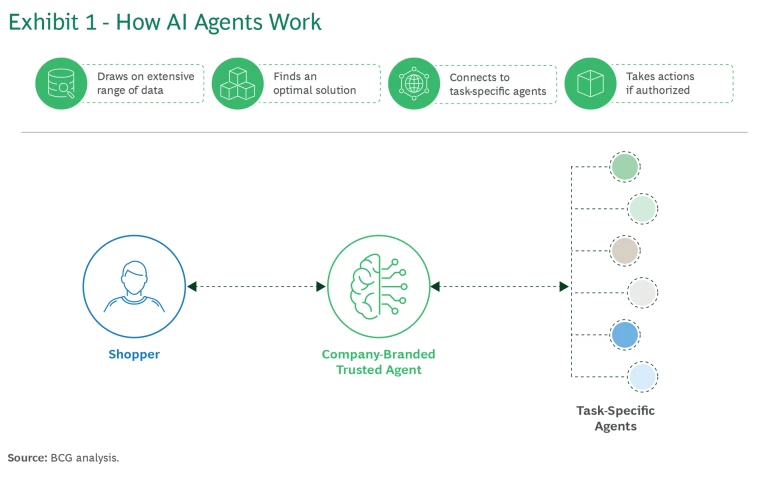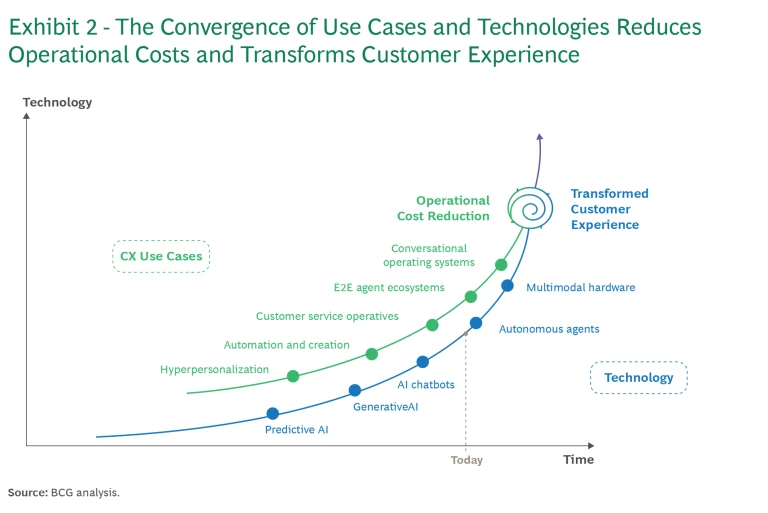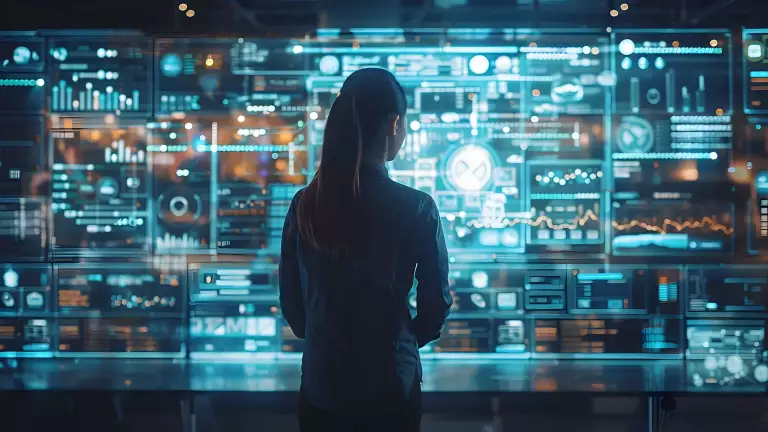Businesses have long recognized the link between improved operational efficiency and a better customer experience (CX). But the rapid convergence of various technological forces—including next-generation hardware powered by virtual agents—is turning that link into a measurable source of value creation. Increasingly well-documented use cases for generative AI (GenAI) are demonstrating that companies can simultaneously offer a different and vastly superior customer experience at a radically lower cost-to-serve that yields significant improvements in financial performance.
To achieve this “holy grail,” companies have begun to look beyond the traditional customer journey —actively managed by shoppers on their apps—to explore the idea of more comprehensive customer “missions” managed by a network of trusted autonomous agents trained to accomplish specific tasks with minimal human involvement. The first attempts in the market today will pale in comparison to what users will see as the convergence between hardware and agents intensifies.
The innovations that make reaching these CX goals feasible are already taking place at different levels. Internally, AI is enabling companies to streamline processes, transform the employee experience, and increase productivity with unprecedented speed. In customer service operations , for example, GenAI has helped companies achieve productivity improvements of between 15% and 30%, with some aspiring to as much as 80% higher productivity.
Externally, AI is driving shifts in how customers engage with brands, making their interactions more human, more personalized, and less tedious and confusing. The virtual co-pilots of retailers, for example, are interacting with customers to answer questions, facilitate returns, and create personalized offers. These co-pilots free up employees to handle customer issues that still require complex or nuanced human intervention.
Linking Process Improvement to Customer Experience
Current investments by Amazon and the Swedish fintech company Klarna show how a company’s AI deployments can deliver benefits internally and externally.
Amazon’s vast and growing population of warehouse robots can pick, pack, and move merchandise more efficiently than humans can. AI applications optimize storage positions and routes within the warehouses and help the robots detect defective or damaged merchandise more reliably than humans, who now take on supervisory and maintenance roles. This efficiency results in faster and more flexible delivery for customers. Amazon claimed that in March 2024 it delivered 60% of orders to Amazon Prime members on the same or next day in the top 60 US metropolitan areas. At the same time, it is aiming to improve cost-to-serve by 25% during peak seasons at its next-generation warehouses.
Klarna, a global provider of “buy now, pay later” payment solutions, introduced an AI customer service assistant powered by OpenAI in early 2024. With 85 million active users, the company reported that within its first month, the AI assistant managed a workload equivalent to that of 700 full-time agents. Customer satisfaction levels were on par with previous satisfaction with human agents, but customers benefitted in several other measurable ways. Repeat inquiries fell by 25% due to greater accuracy in task resolution. Speed of service also improved, with customers resolving problems in less than 2 minutes versus 11 minutes with human agents. In September 2024, the company announced new features for the AI assistant, including open-ended research, searches for specific products or brands, product comparisons, product recommendations, and price research. Klarna has estimated that the implementation of these assistants will yield $40 million in additional profits in 2024.
While efforts like these will yield significant productivity improvements, they will not fully achieve the desired customer, cost, and financial performance benefits unless companies also set the bar much higher for enhancement of the CX. That’s where the convergence of next-generation hardware and autonomous agents creates game-changing opportunities.
From Time-Consuming Apps to Trusted Autonomous Agents
In his keynote address at Dreamforce 2024, Salesforce CEO Marc Benioff said that service employees waste over 40% of their time on low-value and repetitive tasks. We have found that customers who want to buy a car, remodel their home, or just find something fun to do on a weekend face a similar set of challenges. Much of their research—conducted via apps, call centers, or web pages—can devolve into a confusing, frustrating, and error-prone experience. One study by Google revealed that a customer can have more than 700 digital touchpoints over a few months as they try to plan a trip.
Imagine instead that a brand’s chatbot is an agent that is designed and trained to draw complex inferences on its own from the personal information the consumer has allowed it to access. As Exhibit 1 shows, a vertical network of proprietary and third-party agents would work in the background to complete the discrete tasks of a customer mission—such as “get me my new car”—rather than simply serve as the customer’s Q&A machine on a traditional customer journey. The network of agents thus do much of the burdensome work that a consumer would currently need to do manually through an app or a website. As this “agentic AI” learns a user’s unique preferences, it will deliver products, services, and experiences that are more comprehensive and more personalized .

When planning a vacation, for example, a brand’s autonomous agent will use each family member’s unique interests and preferences to suggest destinations; find itineraries; map out routes; recommend flights, hotels, and restaurants; and even make reservations for activities. During the trip, the task-specific networked agents can also track the family’s progress and—through a single user interface—make short-term recommendations for changes based on traffic, weather, activity opportunities, meeting friends, or other conditions. This has the potential to achieve a superior standard of convenience and service and alleviate what can sometimes be a dizzying overabundance of choices while traveling.
If the customer wants to remodel their home, the agents could find the most effective methods and materials, make recommendations, order products, and even generate self-help videos for tasks the customer wants to undertake. Autonomous agents can manage not only major occasional events (travel, car purchase, home remodeling) but also day-to-day tasks such as shopping, diet and workout planning, pet care, and car and home maintenance.
Subscribe to our Customer Insights E-Alert.
Convergence of Technologies Boosts Benefits
Now imagine an AI agent that is multimodal. This is where the convergence between agents and next-generation devices comes into play. Besides revolutionizing specialized tasks and solving customer problems faster, better, and more efficiently, agents also untether customers from their screen-based or handheld devices. The shift from app-based operating systems to ambient, natural interfaces—such as voice, augmented reality, and eye movement—will accelerate as AI-powered devices become more intelligent and predictive. This transformation will drive hardware innovations that blend into a customer’s day-to-day life rather than being a distinct task or experience. In the workplace, employees can use these devices to interact with the company’s agents that help them do their jobs better, providing benefits to customers.
The smart glasses from Meta and Ray-Ban exemplify this. They function as normal eyeglasses, even with prescription lenses, but their built-in GenAI can analyze and interpret what they see along with the wearer. The glasses can take pictures and videos, play music, make video calls, livestream what the wearer sees, and even translate foreign languages. The device anticipated from the collaboration between former Apple designer Jony Ive and OpenAI CEO Sam Altman is expected to have similar benefits in that the product will immerse itself into the wearer’s day-to-day life without the interruptions that occur using a handheld screen.
As agents and hardware converge, we anticipate mutually reinforcing innovations that boost both user experience and customer experience. On the agent side, we expect technical advancements that will bring down the cost of training and operating the underlying models, reduce the risk of hallucinations, and help build stronger and more widespread customer trust to turn over their personal data and much of their life management. In addition to upgraded technology, devices will also offer greater benefits in terms of comfort and style, tighter integration into the flow of work or life, and more responsiveness to a range of sensory cues.
Today’s No-Regrets Moves for Executives
The integration of agents into an organization goes beyond a straightforward deployment of GenAI to test the value of use cases. In line with BCG’s progression of Deploy-Reshape-Invent, the ability to establish a solid connection between radical improvements in operational efficiency and a vastly different and superior customer experience creates an imperative for companies to invent new business models or risk being left behind. These models would serve complex data-driven customer missions (“buy the perfect car for me”) instead of separate customer journeys (“show me mid-size hybrid SUVs”) as the twin forces of autonomous agents and multimodal hardware continue to evolve and converge. (See Exhibit 2.)

But before embarking on a massive customer experience transformation—or even planning one—we recommend a more pragmatic approach for the short term. Companies should start with a small number of deep initiatives that lay the foundation for an eventual transformation. In a deep initiative, the company tests use cases for how AI and GenAI can significantly enhance operational efficiency and customer experience, then comprehensively assesses the effects on the tech stack, the future roles of affected team members, and the required metrics for defining success from a customer, operational, and financial standpoint. At the beginning, the assessments should give greater weight to the operational side, which is a prerequisite for scaling the agents with customers.
In detail, we see several no-regrets moves right now to prepare an organization for a larger transformation.
Build for journeys and design for missions.
The vertical integration in Exhibit 1 will take place first, as agents start to take over parts of the customer journey. At the same time, companies need to start thinking about their role in broader customer missions. The challenge is to understand these journeys and missions and serve them in ways designed from the outset to achieve their CX and financial goals.
Adopt new metrics.
Executives can begin to rethink traditional CX metrics by incorporating new KPIs, such as cost-to-serve, alongside their preferred customer satisfaction metrics. These metrics should allow an executive team to “connect the dots” by making transparent the relationship between lower costs, superior customer experience, and better financial performance.
Re-evaluate investment priorities.
Companies have tended to underinvest in efforts that translate operational improvements into better customer experience, because they considered short-term gains to be soft and uncertain rather than hard and verifiable. The ability to draw direct links between operational efficiency and customer experience, and then calculate short- and long-term ROIs, can attract the investment needed to keep the momentum going.
Learn to converge.
This approach is necessary to keep pace with the accelerating rate of innovation as well as convergence. Convergence will take place not only technologically—such as between hardware and agents—but also within the organization as it finds ways to integrate teams, functions, and skills in ways that drive greater efficiency and a better CX. It means launching deep proof-of-concept tests of GenAI’s potential in different functions, starting with low-hanging fruit, to identify potential pitfalls and address them early in the implementation process.
These actions will enable the company’s leadership team to start preparing a roadmap for integrating GenAI into the customer-experience strategy—from short-term wins to long-term, full front-to-back transformation.
The convergence between ever-improving hardware and larger networks of trusted autonomous agents will allow companies to achieve the holy grail of improved productivity, higher customer satisfaction through a superior and differentiated customer experience, and better financial performance. The familiar link between improved efficiency and better customer experience will become a nexus of innovation and value creation in ways we can only begin to imagine, as the technologies integrate more seamlessly into day-to-day life.
The authors are grateful to their BCG colleagues Oli Shaw, Melanie Stetter Hernandez, and Aylin Ozcan for their insights.















